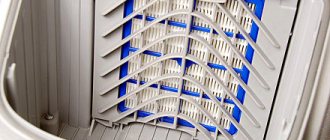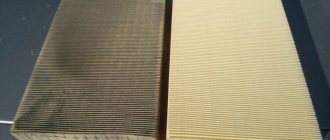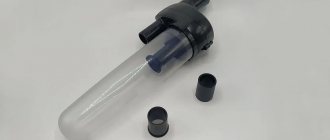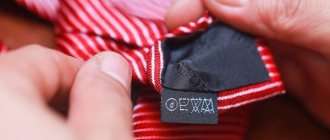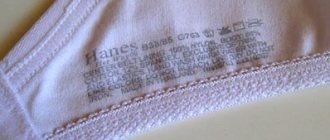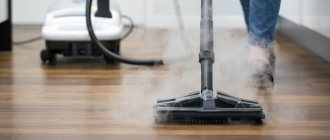Household vacuum cleaners are equipped with various filters for high-quality filtration of the air coming out after sucking up garbage; there can be from one to three of them.
Also, special garbage bags, an aquafilter and a press in a cyclone act as additional filters.
Regardless of the manufacturer of the vacuum cleaner: Samsung, Lg, Bosch, Philips, Karcher, Dyson or another brand, cleaning the same filters is carried out according to the same protocol. In this article we will tell you how to clean all vacuum cleaner filters.
Any cleaning of the vacuum cleaner is carried out only after disconnecting it from the power supply.
How to recognize that a vacuum cleaner filter needs cleaning
The main symptoms of a vacuum cleaner, indicating that the filter elements need to be cleaned or replaced, are the following:
- power drop. The performance of the vacuum cleaner has dropped noticeably, dust is sucked in less efficiently. Engine intermittency may occur;
- heating the motor and turning it off. The electric motor can become so clogged with dust that it fails;
- The vacuum cleaner began to emit an unpleasant odor that did not disappear during operation. This indicates that bacteria have created colonies on the filters and are actively multiplying.
Attention! If the reason for the poor performance of the vacuum cleaner is in the filters, then it can be easily eliminated by cleaning, washing or replacing.
In all types of vacuum cleaners, filter elements require replacement/cleaning as they become saturated with dust. Some products beep to indicate it is time to clean. In others, the degree of contamination is set manually.
You should also pay attention to the packaging. Manufacturers usually indicate the approximate lifespan of filters such as HEPA.
How to care for your turbo brush
In order for the turbo brush to serve for a long time, it needs special careful care. If there are animals in the house, then you need to clean it at least once every three or four cleanings; if not, monitor its condition and clean it as necessary.
To clean the turbo brush, arm yourself with a screwdriver and patience. Carefully unscrew all the screws and fold them separately so as not to lose them. Disconnect the cover and remove the brush shaft. Using scissors and tweezers, free it from the wound debris. Wipe dust between the blades, bearings and V-belt drive. Before installing the shaft, lubricate the bearings with liquid industrial oil. Assemble the brush, connect it to the vacuum cleaner and check the shaft rotation activity by turning on the motor at full power.
Types of filters
Vacuum cleaner models on the market today have different filters. The most popular ones are discussed below:
- Bag. They are made from fabric or paper. Designed to retain and accumulate small debris and dust particles. They are made in two layers in order to prevent contact of debris and dust with the environment during removal.
- Aquafilter. Its operating principle is based on collecting dust using water. The absorbed dirt particles, even the most microscopic ones, are moistened and settle at the bottom of the container. Thus, the collection and accumulation of garbage, even the smallest, occurs.
- Cyclonic. During operation of a cyclone-type vacuum cleaner, centrifugal force is generated inside it. The latter separates dirty air from clean air flow. Garbage and dust settle on the walls and are sent to the dust collector. The air undergoes additional purification and is then returned to the room.
- Thin foam rubber. The location of this filter is at the outlet, in front of the cleaning part.
- NERA. These are the most effective filtration systems. They efficiently clean the air from dust and allergens. HEPA is an English abbreviation, translated into Russian means highly efficient particle retention. They are usually used as an additional element to one of the above.
On a note! Fabric bags are reused many times. Paper – disposable products that are disposed of when filled. And, as a result, the answer to the question of whether a paper filter from a vacuum cleaner can be washed will be negative.
The operating principle of HEPA is based on several physical effects created by complex shaped fibers: entanglement - dust particles stick to the fibers; inertia - particles with a large diameter cannot bend around the fibers and drown in them; diffusion - microscopic dust particles collide and slow down, the direction of their movement moves away from the line of air flow, they stop and settle on the pile; electrostatic adhesion - fibers and dust receive opposite charges, as a result of which dirt settles on the surface of the filter.
Also, vacuum cleaner filters are usually classified into primary and deep.
Primary
This category includes coarse filters and waste storage devices, which are garbage bags or plastic containers. Their main location is the space between the inlet hose and the engine filter.
On a note! Premotor sponge filters should also be considered primary filters. Their main task is to protect the engine from dirt, thereby extending its service life.
They need to be changed more often than others, as they get dirty faster than other filters. They are located in front of the engine compartment, as well as at the air outlet of the vacuum cleaner.
Deep
As a rule, the installation location for deep (fine) filters is between waste collection containers and engines. Their main task is to capture the smallest dust particles. In most cases, these are representatives of HEPA filters.
Another fine filter is carbon. Usually these are honeycombs with compressed activated carbon installed in a plastic cassette. Designed to capture odors. Dust is not captured. They are used exclusively as an addition to the main filters.
Cloth or paper bag
Models with such “filters” are especially popular because they are in the middle price segment, are easy to use and last a long time if used correctly.
Paper bags are considered disposable; they are removed and thrown away when filled without opening.
For fabric dust collectors that are reusable, the following cleaning algorithm is used:
- Remove the bag from the plastic holder inside the vacuum cleaner and carefully remove it, trying not to make sudden movements. This will prevent the spread of dust and debris.
- Transfer the bag into a large plastic bag of such a size that the dust container can be turned over and the contents can be poured out.
- After waiting for the dust to settle, carefully pull out the bag, and dispose of the plastic bag with the garbage.
- The bag is cleaned by machine or by hand, depending on the material. The dust collector should be dried naturally on a clothesline.
Most instructions on how to clean the filter of Samsung and other brands of vacuum cleaners do not recommend wet cleaning of the bags. However, it is recommended to carry out this procedure occasionally in order to achieve better cleaning of the dust collector from dirt.
Is it possible to wash the filter from a vacuum cleaner?
Manufacturers provide recommendations for cleaning them in the instructions, which also indicate whether the filter from a vacuum cleaner can be washed. And if they do not provide for washing the product, then you should not take risks.
The main material in the production of vacuum cleaner filters is paper, and HEPA is no exception.
Those products that are made of plastic and synthetic fabrics not only provide for washing and cleaning filters, but also make it mandatory.
From the above it follows that disposable ones are not washable, like thin synthetic ones.
Fabric filter bags can be washed and cleaned, but the dirty contents must be removed first.
We recommend:
The best steam mop for the home: rating of powerful and budget ones
Washing dust collectors whose operating principle is based on centrifugal force is possible. Typically, as the instructions prescribe, cleaning them occurs by wiping the insides with a damp cloth and, if necessary, rinsing with water.
Aquafilters themselves already work in a humid environment. Washing them involves pouring out the dirty liquid and then rinsing them.
Foam rubber can and should be washed. However, they do not tolerate strong spinning and may tear. It is recommended to let them dry on their own.
HEPA filters are also reusable. These active parts are made of fluoroplastic materials and as a result they can be washed. Their subsequent use occurs without loss of performance.
What else is the equipment intended for?
Using a similar technique as washing windows, furniture is cleaned - the device is prepared for work, a brush is installed for washing flock fabric. The actions are carried out from top to bottom in dry mode, then clean liquid without cleaning agents is poured into the container. One approach is enough to refresh the upholstery. To remove dirt in hard-to-reach places, use a crevice nozzle with a narrow spout.
A washing vacuum cleaner also cleans furniture
Washing vacuum cleaner and functions:
- cleaning the floor surface;
- cleaning upholstered furniture;
- window cleaning;
- cleaning curtains;
- removing stains from tiles and linoleum.
Step-by-step instructions for removing stubborn dirt from furniture:
- prepare the composition;
- the resulting solution is poured into the tank;
- nozzles are installed;
- up and down movements under high pressure dissolve dirt;
- debris is removed from the surface using a vacuum suction;
- removal of dirty liquid;
- washing the container;
- refilling with clean water without using any products;
- additional processing.
Existing methods for cleaning vacuum cleaner filters
In practice, two methods of cleaning vacuum cleaner filters are used. Both of them are aimed at restoring their functionality.
Using water and detergent (aqueous)
Those filters that can be washed are simply rinsed under running water. Next, they should be dried thoroughly.
Important! It is not recommended to use any detergents to wash filter elements. The structural components of filters can react unpredictably to household chemicals, changing their characteristics for the worse.
A wet filter cannot be used, as the air flow through it will decrease and the suction power will decrease. The vacuum cleaner motor will work with increased load.
Blowing or knocking out (air)
In fact, the air cleaning method is applicable to all filters. This is especially true for products made of paper and other fiber elements. The cleaning process is simple - the filters are blown with air, preferably compressed (from a compressor for inflating car wheels). The air flow should be directed in the opposite direction to the direction of filtration.
Description
Hera for a vacuum cleaner
The Hepa filter consists of an accordion-shaped fibrous sheet and a housing that holds it in this state. It is made from fiberglass fiber with a diameter of 0.5-2 microns.
The operation of the unit is determined by the volume of particles released into the environment after the air flow passes through it.
The classification is based on the degree of filtration of small contaminants. It is defined by the standards pr EN 1822/ pr DIN 24183.
It is more correct to divide products into ULPA, HEPA, EPA, but consumers call Hepa filters, because they appeared before the names were divided.
Hera filters for modern vacuum cleaners are divided into classes.
| Hera filter class | Dust retention percentage |
| 17 | 99,999995 % |
| 16 | 99.9999 5% |
| 15 | 99.9995 % |
| 14 | 99.995 % |
| 13 | 99.95 % |
| 12 | 99,5 % |
| 11 | 95 % |
| 10 | 85 % |
It is necessary to pay attention to the class when purchasing an additional filter for a vacuum cleaner. The higher it is, the better and more reliable the product.
What happens if you don't change the filter on time?
Vacuum cleaner filters play an important role in the cleaning process. They protect the device’s motor from dust contamination, overheating and operation in extreme conditions. If the filter elements are clogged, and this often happens, the suction power of the vacuum cleaner decreases. The unit begins to operate noisily. And if you don’t take action, don’t change them on time, don’t clean them, this will lead to engine failure.
Additional Tips
When cleaning a computer with an electric vacuum cleaner, it is recommended to take into account the following tips:
- Before purging, you must remove the wires from the fan.
If this is not done, then under the influence of air jets the cooler will begin to rotate, generating energy. This may lead to failure of other parts of the device. - When blowing through the system unit, it is recommended to hold the fan blades.
Due to air currents, it will begin to rotate vigorously, which can accelerate its failure. Blowing through the fan with a vacuum cleaner also negatively affects the operation of the entire computer. If it is carried out frequently, the cooler begins to cope worse with the function of cooling the computer elements, which provokes a general slowdown in its operation. - It is recommended to blow through a computer or laptop with an electric vacuum cleaner first in the air suction mode, and then in the blowing mode. This will make cleaning more effective.
It is recommended to use not an ordinary household vacuum cleaner, but a special blower to clean the computer. It is more powerful and does not generate static electricity during operation.
An air can can also be an alternative. This is a special device for removing dust from hard-to-reach places on a computer.
Thorough cleaning occurs due to the fact that the air inside the can is under pressure, and the nozzle on it is a long thin tube.
Side brushes
The auxiliary brooms are located in the front part of the bottom; they are the first to come into contact with the debris lying on the floor, which is why they wrap a large amount of hair around themselves during rotation. Untimely cleaning of the side brush leads to excessive rotation force and rapid failure of its electric motor. The brush maintenance procedure is extremely simple:
- Remove the brush. On older models, the brushes are attached to the shaft with screws, which can be unscrewed with a Phillips screwdriver. On more modern robots, the fastening is implemented according to the latch principle - in this case, you just need to pull the brush towards you.
- Gently untangle the hair and wool using a cutter.
- Wipe the fastening axis with a damp cloth and put the brush in place.
Maintenance is carried out as needed, on average once every 7-10 days.
Elimination of unpleasant odor
If we are not talking about the smell of burning plastic, the equipment does not burn, then its reason is not a violation of functionality. First of all, it is advisable to replace the collection bag. Over the course of a series of cleanings, dust, hair, and germs accumulate in it. Warm air escapes from the vacuum cleaner through these contaminants, creating an unpleasant odor.
If replacing the bag does not eliminate the odor, clean or replace the filters. If they are clogged, dust can get into the engine and settle on its armature, which also creates an odor. Before purchasing replacement filters, determine which one you need - input or output (one is thinner, the other is denser).
In some older devices, the smell does not go away with cleaning. In this case, the following advice will help. Buy fragrances designed for use directly in vacuum cleaners. In addition to neutralizing odor, some aromas are even beneficial for the human body, playing the role of aromatherapy.
Brushes and hoses
Sometimes the hose is so dirty that it cannot be cleaned by regular wiping. In this case, you need to do this:
- Disconnect the part from the vacuum cleaner.
- Immerse in a bath of soapy water.
- Wash the hose with a soft sponge.
- Remove and let dry.
You can assemble the parts together only after complete drying.
If the hose has switches or contacts, all that remains is a damp cloth - and no water procedures. The presence of these elements can be found in the instructions. If there is a strong blockage inside, the hose should be blown out with a vacuum cleaner before washing. Or use a long piece of wire to remove large pieces of debris.
The turbo brush must be cleaned after each cleaning, as hair, threads and animal fur get wrapped around it. Over time, the rollers become dirty, making the device difficult to operate. The action plan is as follows:
- The protective cover must be removed, the screws unscrewed, and the turbo brush disassembled.
- Remove debris and hairs with your hands or tweezers if you cannot reach them with your fingers.
- Wipe the inside of the turbo brush with a damp cloth and assemble it.
- To avoid losing the screws, they must be placed in a cup or deep container.
Particular attention should be paid to the places where the hose connects to the handle, and the handle to the brush. Debris most often accumulates on the bends, impeding the movement of air in the vacuum cleaner.
Conventional brushes are cleaned in the same way, but disassembled easier and faster: the side wheel is removed; The rod is washed.
Procedure
Before cleaning, the vacuum cleaner must be turned off from the mains voltage to avoid injury and electric shock. Further:
- Place the device on a bare floor - wiping its surface is much easier than removing accidentally fallen debris from the carpet.
- It is advisable to moisten the vacuum cleaner using a spray bottle to bind dust particles when disassembling equipment.
- Wipe the cord with a damp and then a dry cloth, wind it up so that it does not interfere.
- Open the vacuum cleaner housing, remove the filter and clean it in the most suitable way.
- A disposable bag is thrown away along with the garbage, but it is better to shake out the dust from a permanent bag into a separate plastic bag. Then close it tightly and put it in a bucket.
- The water filter must be washed and dried after each use.
- The cyclone container is cleaned of dust, washed under running water and wiped with a dry cloth.
At the end of the internal “audit,” you need to wash the outside of the hose and wipe the body with a damp cloth. Wait until all the parts are dry and assemble the vacuum cleaner.
If the output filter cannot be removed, it can be blown out.
